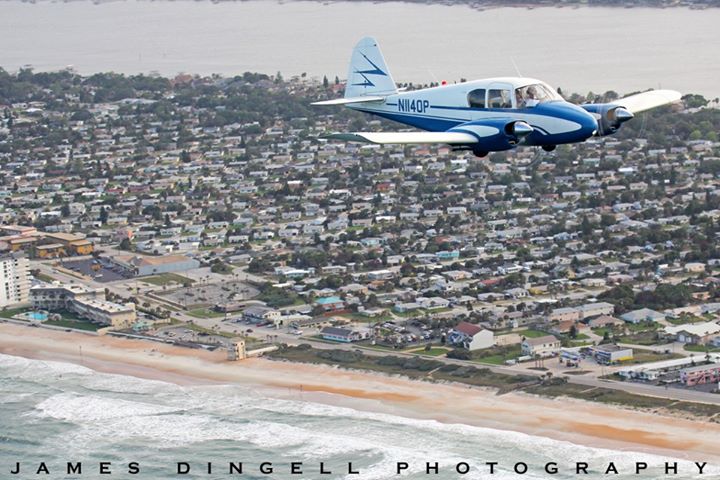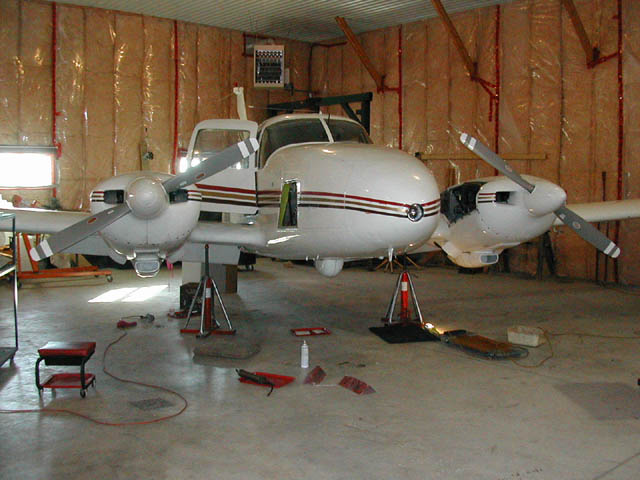Last January was an exciting time for me. Not only was I coming back from the Holiday Break as a junior, but I was coming back as an aircraft owner. A Piper PA-23 Apache, N1140P had came up for sale on the market during the last few weeks of December 2012 at an airport just a short drive from my house. I had been looking at light piston twins for the entire fall just researching and feeling out the market, and this Apache was the airplane I had been looking to get for quite some time.

Here’s my Apache over Daytona Beach in the Spring of 2014. Light piston twins can be a great way to travel and fairly economical if you fill the seats on long hauls. Photo credit James Dingell.
The Piper Apache started out as a design from the aircraft manufacturer Stinson in the late 1940s and early 1950s. Eventually making its way to Piper, the Twin Stinson name was swapped out for the Apache, starting the long line of “Indian Pipers.” The early Twin Stinson had smaller Lycoming engines and an “H” tail design, not unlike the B-25 Mitchell bomber. The Apache was really the first light twin piston engine airplane to make it big on the market as everything before it was quite large, such as the big Beech 18 Twin Beech and Cessna T50 Bamboo Bomber.

The onset of the Apache was quite a significant one as the airplane was really the first “light” piston twin to catch on in the general aviation market. It was touted as a smaller business airplane but doubled as a family station wagon as well. Just as the advertisement says, the Apache is quite the utility airplane with it’s rugged twin engine design and extremely roomy cabin.
Buying an airplane is quite easy, hand over the money or sign finance paperwork at the bank and it’s yours, but it’s the other things that make aircraft ownership rough. Insurance has to be found and paid for and a hangar or ramp space for the airplane is also needed. An annual inspection of the airplane is required which can set you back some serious cash and if you’re flying for hire, a 100-hour inspection is needed every, yes you guessed it, 100 hours of flight time. Then you have the consumables: fuel, oil, oil filters, tires, light bulbs, all of the little stuff. It really does become an expensive toy very quickly.

Annualing an airplane is quite expensive, and on a complex airplane (one with retractable gear and flaps and a constant speed prop) like this Piper Aztec or my Apache, it gets even more expensive and time provoking.
It might seem like there’s a lot to keep straight when owning an airplane, and there is, but it all teaches you to be a better manager and teaches you to take care of the equipment you are using. In flight training, most people have total disregard for the equipment they are using, but when you own the machine it changes all perspectives about the joy of flight. Owning a light airplane can open all sorts of doors for you. Just driving up to a hangar and getting an airplane out and not having to schedule one at a flight school or jump through a lot of hoops to get into one and rent it is quite nice. The disadvantages are quite minor ones, like cleaning and detailing the airplane. If you’re going to have it, you might as well keep it spotless, right? I have spent many late nights and early mornings keeping the ole Apache clean, and it’s quite enjoyable in itself when it’s all finished and polished up.

Owning or even just taking care of an airplane is quite the task. One of the most enjoyable parts of owning an airplane is seeing it shine and gleam at the end of a long day of flying.
As you can probably tell, I absolutely love my airplane. Owning one is quite expensive, but the advantages and experience that one can pull from it is priceless. Going flying isn’t the only thing to it, the management skills and dedication needed can really teach a person a lot about life in general. It is a great way to really experience aviation!
Happy flying,
Kyle


